
Posts may contain links to products and services I love. I may make a small commission from them, at no extra cost to you. Thank you for supporting my blog.
12 Reasons to Love Winter Camping
While you might be wary of winter camping, there are definite advantages to camping in the cold. After reading this list, I hope you give it a try.
1. No bugs
Mosquitoes and ticks that pester you in other seasons are non existent in the winter.
2. Escape the crowds
Campsites that are overrun in the summer are all yours in the winter. If you haven’t experienced the solitude of a snowy woods campsite, you’ve missed something special.
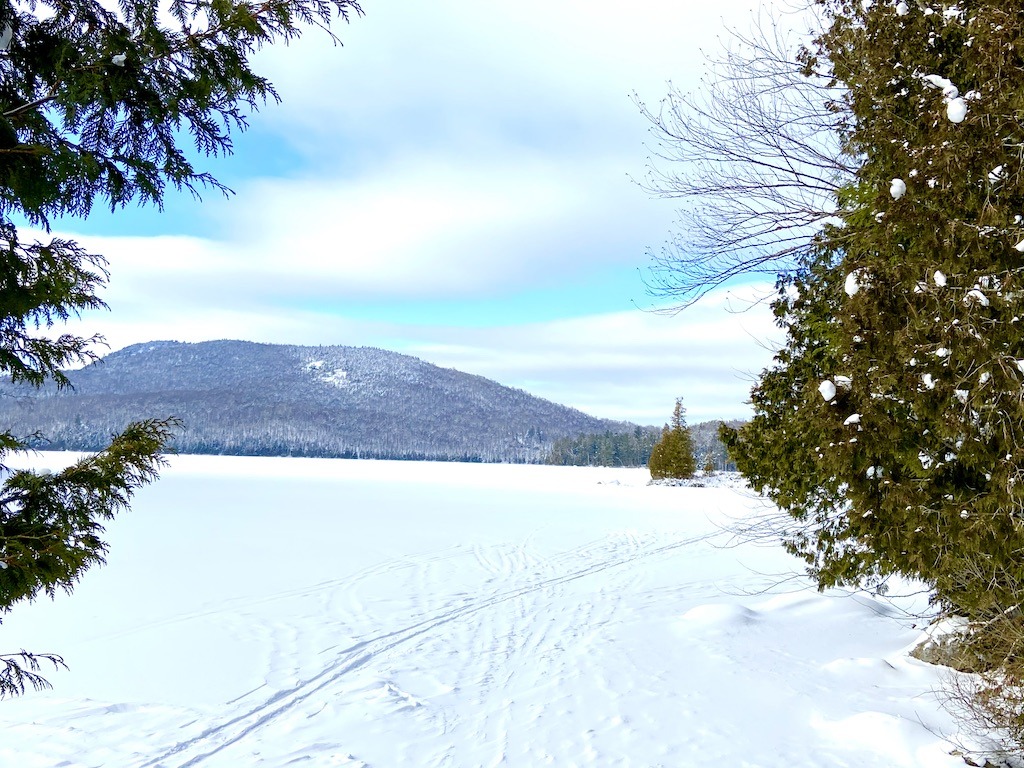
3. Water, water everywhere
There is no need to search for an elusive water source to fill up your flask. Instead, there is plenty of snow to melt for hydration needs.
4. Eat to your heart’s content
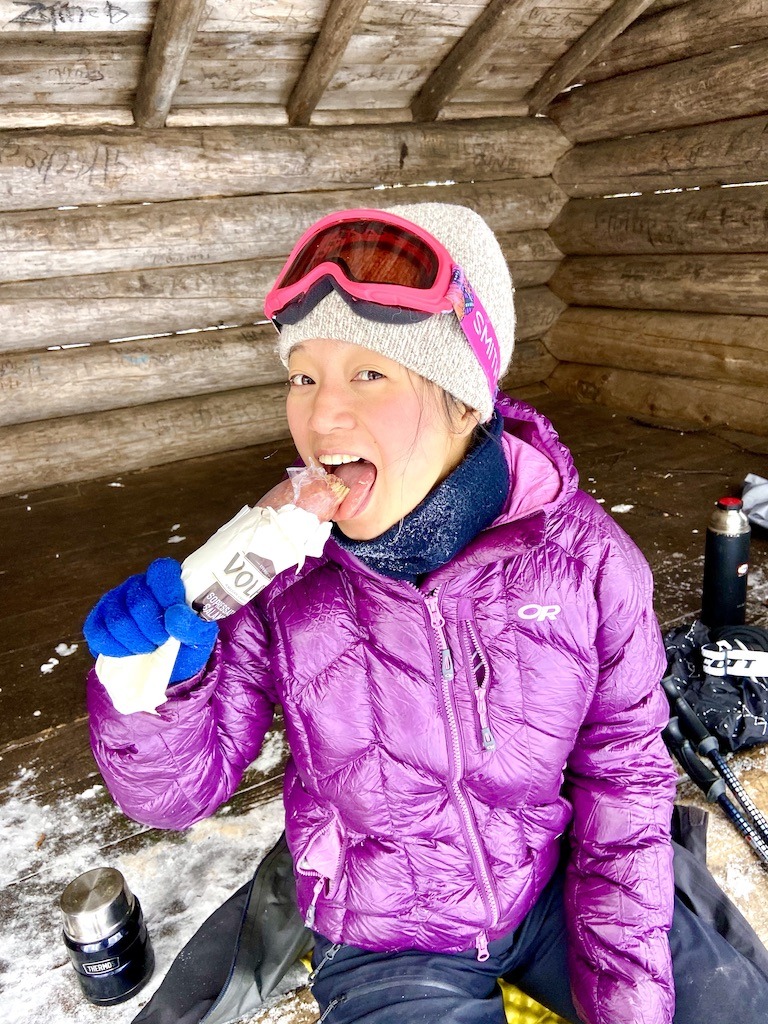
To keep warm in winter, your body needs about 3500-5000 calories. That’s a lot of fatty, sweet, carbo yummy food to ingest.
5. Become a better camper
To stay warm and dry you need to have your systems dialed. Therefore, winter camping requires you to be organized and methodical.
6. Save money
Many campgrounds don’t collect fees in the off-season. Free backcountry campsites are more available in the winter.
7. Starry starry nights
There is nothing like watching the constellation Orion rise in a perfectly clear night sky. Winter skies are a star watcher’s dream.
8. Critters
Fresh snow highlights the tracks of wildlife in the area. You might be surprised by all that’s out there. Listen for subnivean (love that word) life. These are the creatures like voles and mice that live in tunnels between the snow and the ground.
9. Snow architecture
Building snow structures for sleeping or cooking areas is a ton of fun. Remember building snow forts. Well, winter camping let’s you reclaim your childhood with functional snow architecture that keeps you warm and protected.
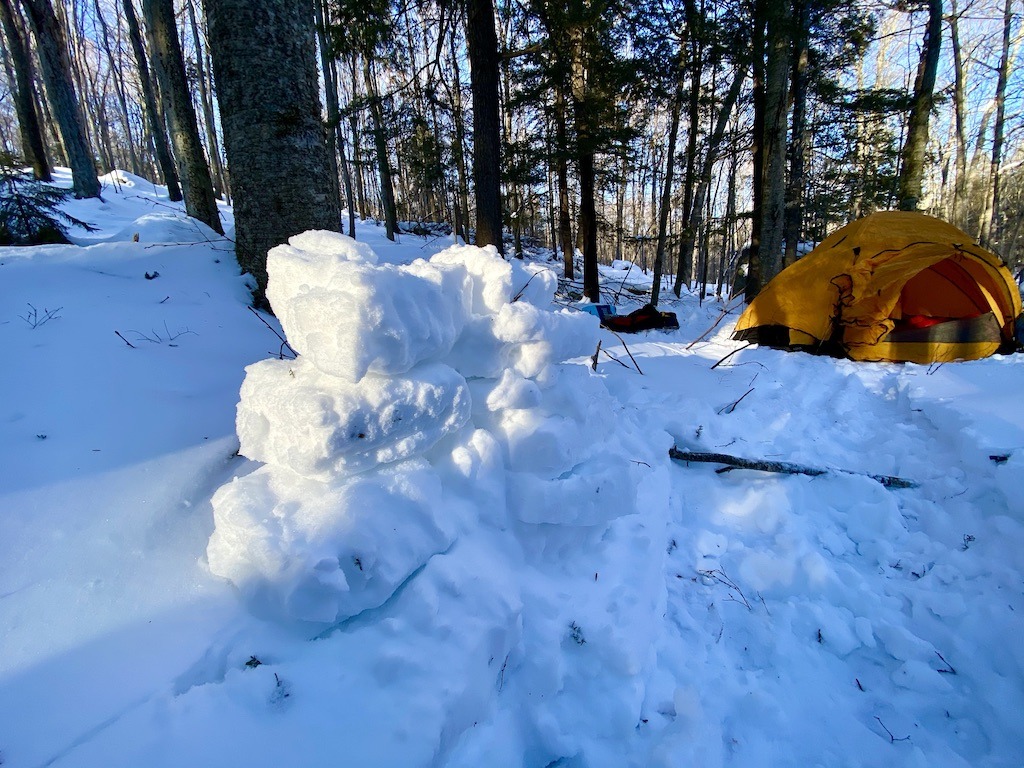
10. Snuggle time
To sleep warm in your tent, snuggling up to your tent mates is key. Plus, with long winter nights, you’ll have plenty of time in your sleeping bag to catch up on sleep.
11. Outhouses don’t smell
The stuff in a privy is frozen so it lacks the fragrance it usually has in warm weather.
12. True grit
Winter camping can be a welcome challenge that builds skills and confidence. Your friends will be impressed by your fortitude (or your foolishness depending on how they view winter camping).
Types of Winter Camping
Winter camping has two schools of practice to use in staying warm. Hot tenting is when you use a specially designed walled tent with a wood stove to stay warm. Cold camping is where you stay warm using your body heat to supplement insulating gear.
Advantages of hot tenting is that the external heat of a wood fired stove can delightfully stave off low temperatures and also dry your gear. This type of winter camping has more bulky equipment so you can’t travel far in the backcountry. It takes more time to set up camp and to find enough wood to power the stove.

Cold camping has no external heat source. Staying warm is predicated on stoking your body’s metabolism. Plus, you need to use the proper gear to protect yourself from getting wet and cold. It’s easier to travel distances with cold camping. And setting up camp is a breeze compared to hot tenting.
While both have their highlights and challenges, I’ve done way more cold camping. Therefore, this article will cover the tips and techniques of cold camping. With the hope that you experience warm camping!
Stay Warm While Winter Camping
The equation for staying warm in the winter is layers minus moisture plus body metabolism equals comfort.
Dressing WISE-ly for winter camping
Laying your clothing is the first step. I like to use the acronym WISE for successful outdoor dressing. Sweat is your enemy when winter camping so you need to do everything you can to reduce moisture in your clothes that will steal warmth away. Dressing WISE-ly will accomplish this.
WISE dressing involves the following:
W is for your wicking layer. This base layer is snug next to your skin. Its job is to wick moisture away. Therefore it is made of a nonabsorbent fabric such as polypropylene, wool, or silk.
I is for your insulating layer. This is your cozy puffy layer. It is designed to trap air that is warmed by your body. Fabrics that make good insulating layers are fleece, down, microfiber, or the wool sweater you got at Goodwill. It needs to be breathable and loose-fitting.
S is for your shell layer. This is the water-resistant outer layer. Your shell will keep you warm by blocking the wind and resisting moisture from the outside. Snow will melt very quickly on your inner layers, so the shell protects them.
E is for an extra layer. It’s the backup if a layer gets wet or isn’t warm enough. In winter camping, I recommend bringing three critical extra layers. The first is a parka that you can throw on when you stop. A lunch break will be more pleasurable with a down coat on your quickly cooling body. The other two layers are an extra base layer and socks. These are for sleeping. I’ll talk about them later.
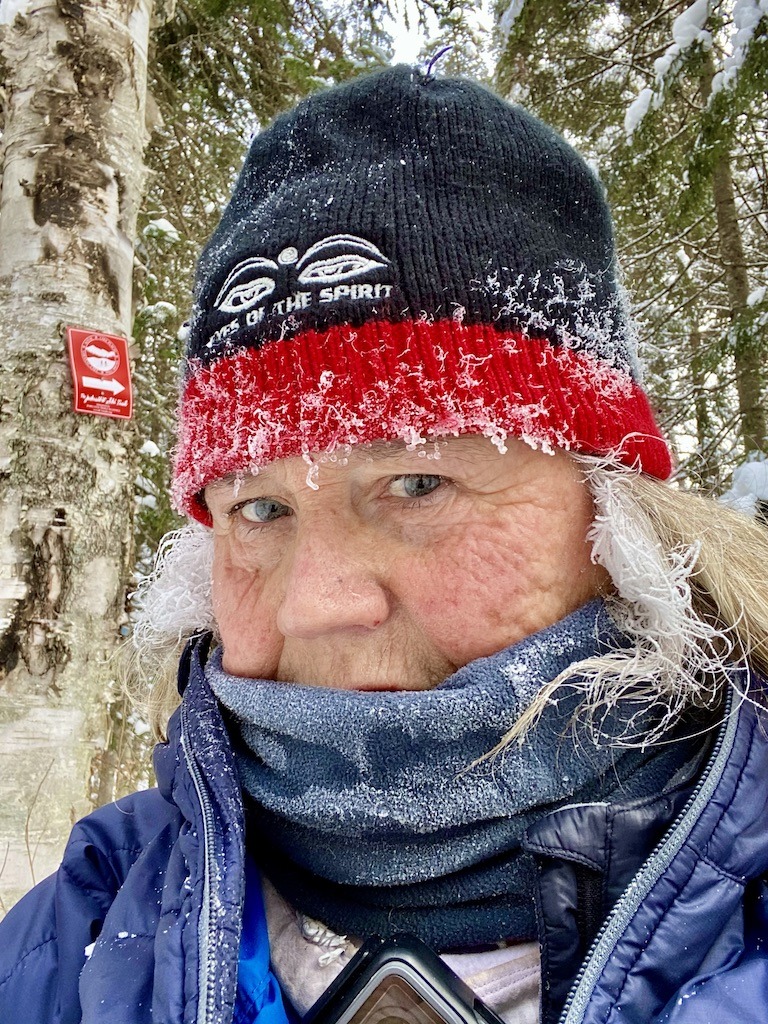
Full body layering
The WISE system can also be used when thinking about your lower body, your hand, and your foot systems. For example, WISE foot covering would be a thin silk or polypropylene Wicking liner sock covered with a thicker Insulating merino wool or synthetic sock. Your waterproof winter boots are your Shell layer with an extra pair of socks in your daypack as your Extra.
The layering system will only work as well as you conscientiously regulate your temperature. Remember that evil moisture that makes you shiver in the winter. Remove layers before you sweat. Vent using the armpit zippers on your shell or side zippers on your shell pants. Furthermore, you should start your hike feeling a little chilly. “Be bold, start cold” is the mantra. You will warm up quickly without sweating.
—> Related post: Proven Winter Hiking Tips
Eating and hydrating to stay warm while winter camping
The second part of the staying warm equation is helping your body’s metabolism generate internal heat. Therefore, in the winter gluttony is good. A diet of 3500-5000 calories is normal for winter campers.
Fatty food creates needed energy for the winter camper. However, fats metabolize slowly therefore a combination of fats, carbohydrates, and proteins are ideal. GORP (good old raisins and peanuts) or trail mix is perfect as it has fat from chocolate, carbs from dried fruit, and protein from nuts.
Winter camping food
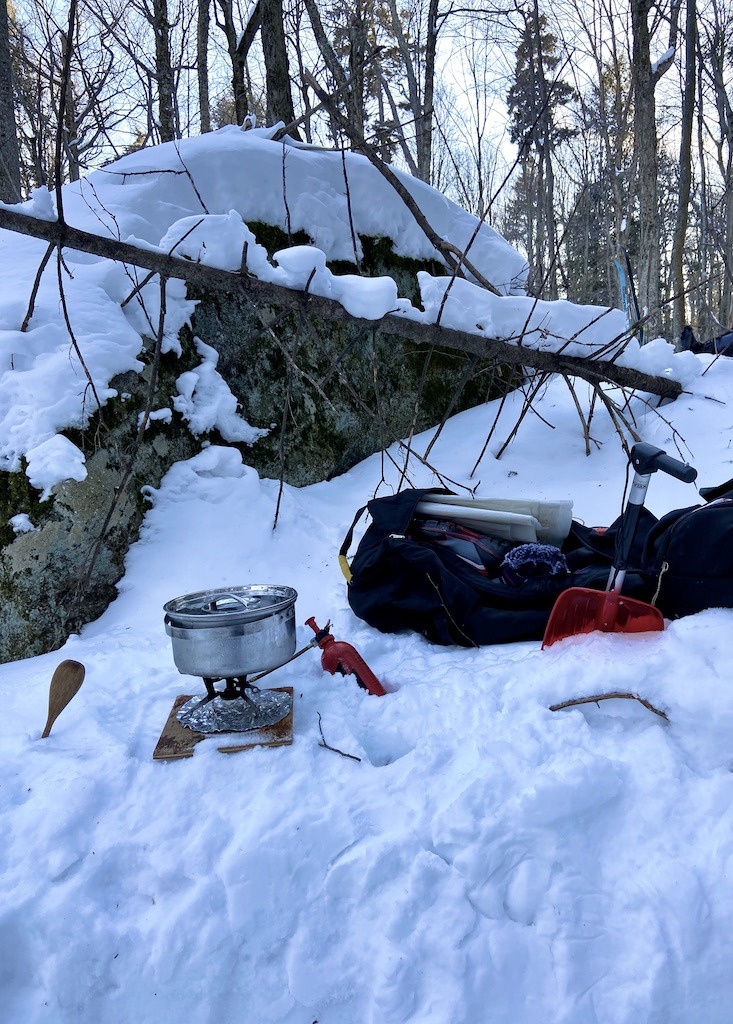
Winter camping meals should be quick and easy to cook. Dehydrated meals are popular but I prefer to make my own meals for budget and taste reasons. Mac and cheese with frozen peas is a favorite. Remember that fresh vegetables will freeze so bring them either dried or frozen. Instant soups are great for dinner as they help hydrate you as well.
For lunches, bring high-calorie food like cheeses, sausages, and nut butters. Dried fruit and nuts are also yummy. Sweets like cookies or chocolate bars are popular.
Breakfast is hot or cold cereals accompanied by a hot drink. Bacon and sausage will boost the fat content of the meal. I add a stick of butter to the oatmeal or pasta pot or put some in my cocoa to add calories. Some people think this is crazy. A quick story to show otherwise.
I was leading a winter camping ski trip in Yellowstone. We were out in the wilderness camping for 17 days in the snow. We stayed warm in temperatures that dipped to minus 30 F. at night. Near the end of the trip, we were tired of the crust of fat that accumulated on our dishes, so we decided for that day not to put butter in anything. That night we all froze even though the low temperature was somewhat warmer. Why? Because we didn’t have enough fat in our diet. For the rest of the trip, a stick of butter went back into every meal.
Pro tip: Food will freeze solid very quickly while winter camping. One time my students brought fresh-baked loaves of bread on a winter trip. The loaves froze into cold cement blocks. Consequently, we used a hatchet to wack off bits to eat. Avoid this by making sure you cut blocks of cheese, meats, or bread into smaller bite-size pieces.
Winter camping hydration
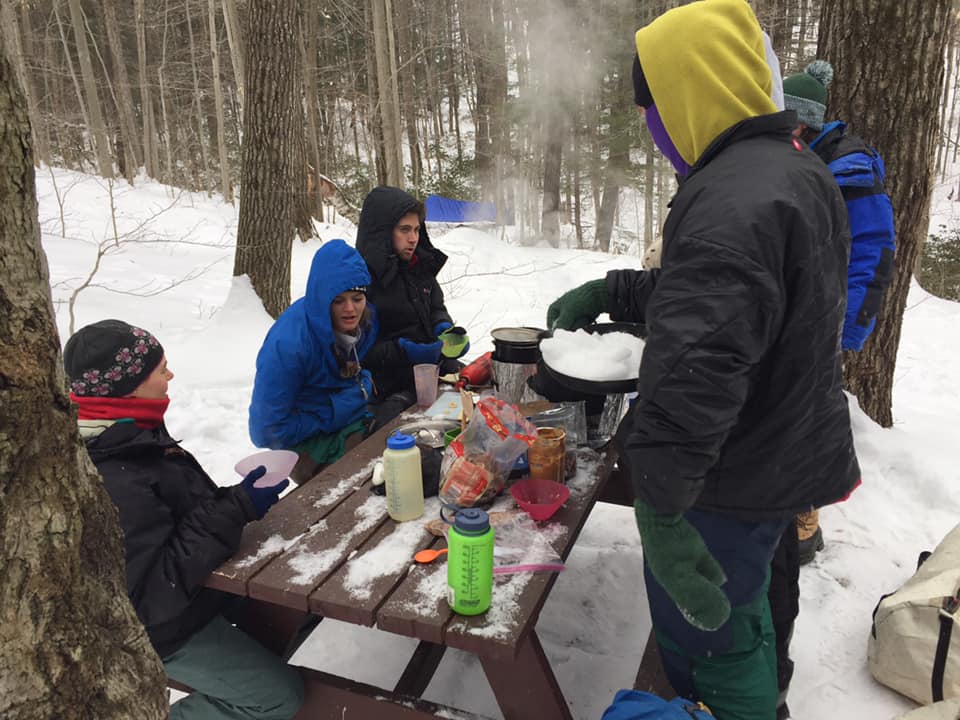
Your body needs more water in the winter to accommodate all that increased metabolism. However, it’s harder to drink cold water in the winter. That’s because, in its effort to stay warm, your body physiology dampens your thirst response.
However, you need to drink 4-6 liters per day when winter camping. Dehydration will make you cold very fast. To know if you are drinking enough, monitor your urine color. Your aim is to pee clear. If it’s dark yellow, start drinking.
Pro tip: Water bottles freeze from the top down. Therefore, if you carry your water bottle upside down, the cap won’t freeze. Also, put your bottle in a thick sock or insulating cover to slow freezing. On super cold days, you’ll need to carry it next to your body or you’ll have an ice bottle.
Setting Up the Winter Camp
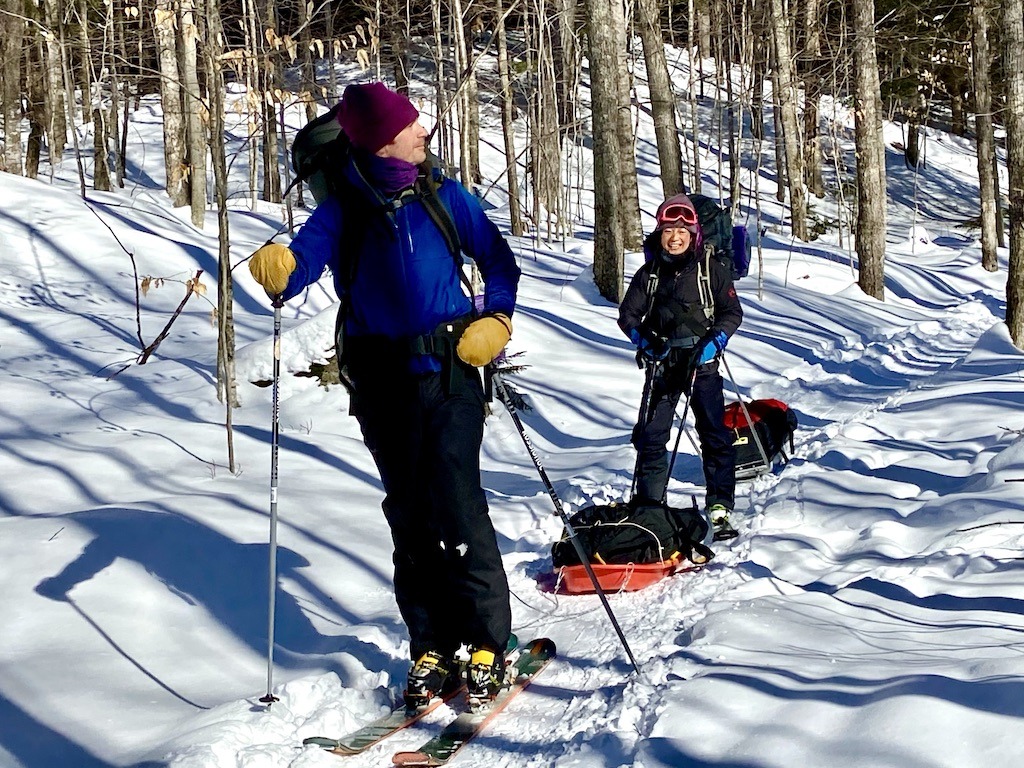
Making a cozy winter camp can be a lot of fun, especially if you are creating snow structures for cooking or sleeping.
Winter camp selection
Choose a camp that is out of sight of the trail and 200 feet from a water source. Leave No Trace camping is important in the winter too.
As cold air settles into valleys and ridge tops are windy, select a campsite between the two. A flat area with trees for tarp/tent pitching and a water source nearby is ideal. While melting snow is realistic, it is time-consuming and takes more fuel. Therefore, getting water from a stream or lake is much easier. You may have to bring an ice ax to get to the water.
Building with snow while winter camping
First you want to build a tent platform for your tent. Look up to make sure there are no widowmaker branches that could fall on the tent. Then, snowshoe over an area slightly bigger than your tent.
By compressing the snow, you are starting a process called sintering. Sintering occurs when the crystal structure of a snowflake is disturbed by pressure or movement of the snow. The broken snowflakes refreeze into a hardened mass. Think making a snowball.
You can use sintering to your advantage to make solid tent platforms, snow kitchens, snow blocks, and snow shelters. Snow is an amazing insulator so snow sleeping structures are surprisingly cozy.
Snow kitchen
The best snow kitchen provides a sturdy cooking platform for your stove plus a bench area to enjoy meals with group members. To build a snow kitchen, dig a trench and pile the snow up on either side. Press the snow down on the sides so it sinters. Build a wide, waist-level platform on one size. Compress the snow and it will soon harden into the perfect snow countertop. When it’s firm, layout your kitchen. A stove pad of ensolite or wood will keep the stove from melting into the snow. You can also cut cupboards into the firm snow for your food or cooking gear.
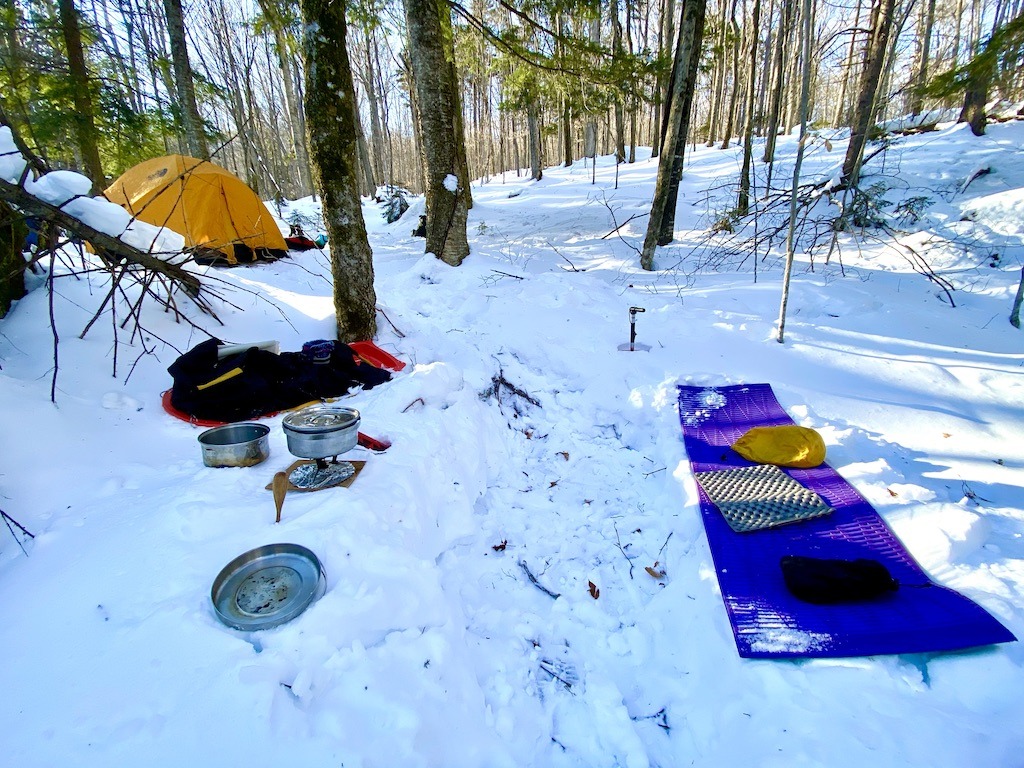
The other side is the dining room. Make benches by packing down the snow and waiting until in sinters and is firm. Cover the benches with Ensolites or sleeping pads for a cozy spot to enjoy meals. With a big group, make the sitting area away from the kitchen to reduce chaos in the cooking area. If you are cooking on a fire, make the snow kitchen surrounding the fire.
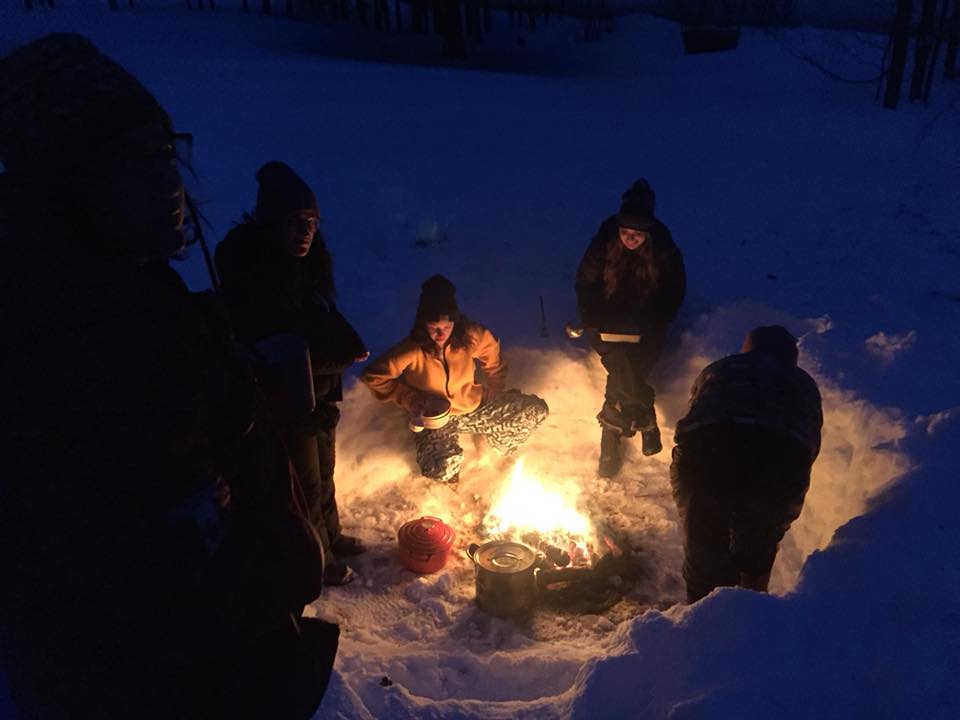
Quinzhee shelter for winter camping
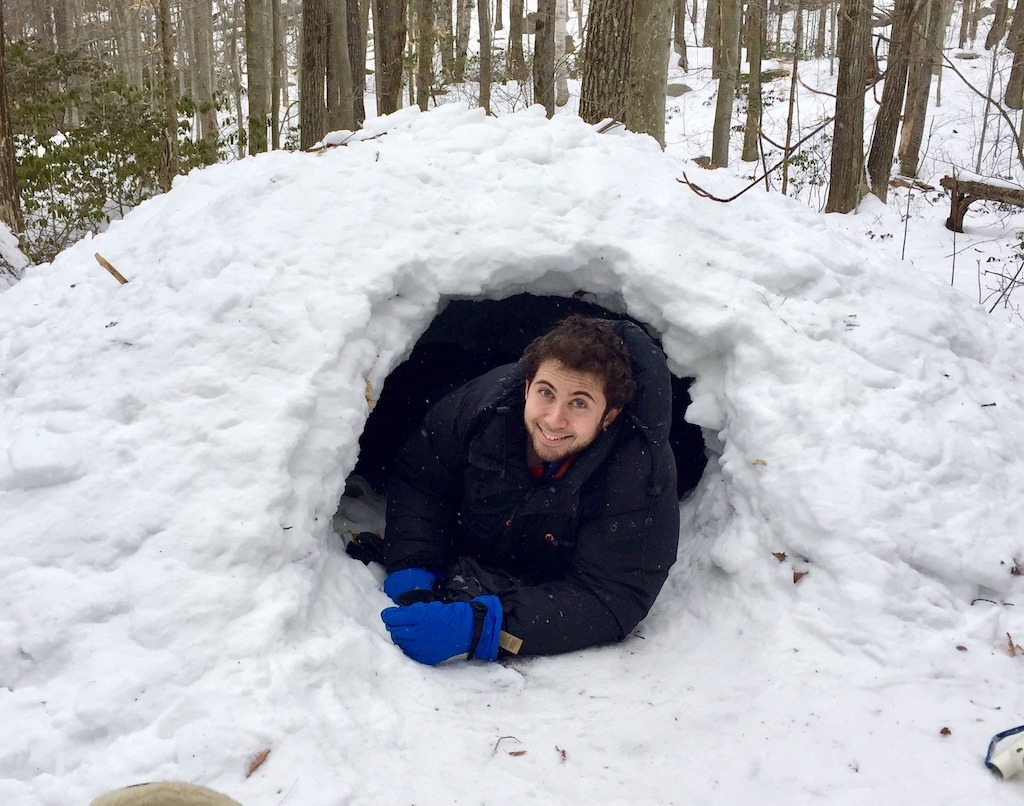
A quinzhee is a super warm sleeping structure for winter camping. It takes a few hours to construct but it’s fun to build and sleep in. First, shovel a heaping mound of snow into a dome shape. The circumference of the pile should be a bit larger than the sleeping space needed for the number of people housed. Tamp down the snow as you build. Let the pile rest for a few hours to sinter. Next, insert sticks at intervals all over the dome. The sticks should be inserted about 6 inches into the snow. When you are digging out the inside, stop digging when you reach the stick. This will ensure a 6-inch thick ceiling in the quinzhee. People fear that the ceiling will cave in on them (which I’ve never seen) so knowing that it’s just 6 inches is comforting.
After the quinzhee is dug out, expand one of the stick holes to create an air hole. Cover the bottom with a ground cloth and spread out your sleeping systems. A candle placed in a dugout pocket in the wall will give you all the light and heat you need.
Pro Tip: When piling up the snow for the quinzhee, put a couple of backpacks down first, then bury them in the dome. You will end up having to shovel less snow. Digging them out also makes less snow to dig out of the shelter.
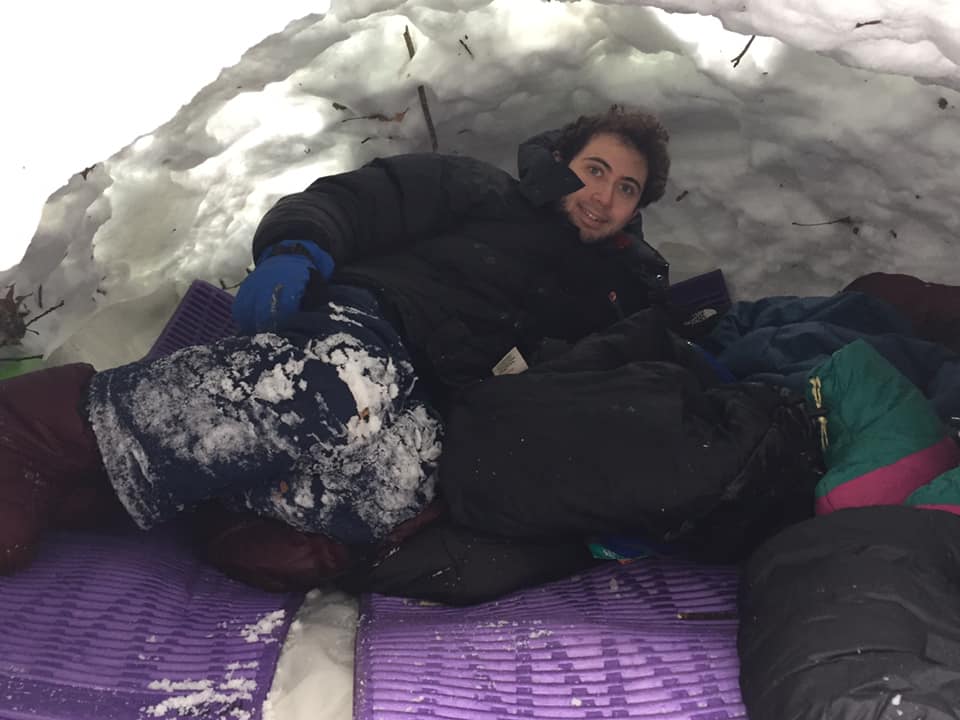
Snow trench for winter camping
The quickest snow sleeping shelter to build is a snow trench. They are great in an emergency, but I also like a snow trench as an easy sleeping alternative to a tent. To make one is simple, dig a trench in the snow. Make it as wide as the number of people who will share it. One or two people is ideal. You can build up the side walls with snow blocks cut out of sintered snow. Finally, pitch a tarp over the trench so you can enter and from one end.
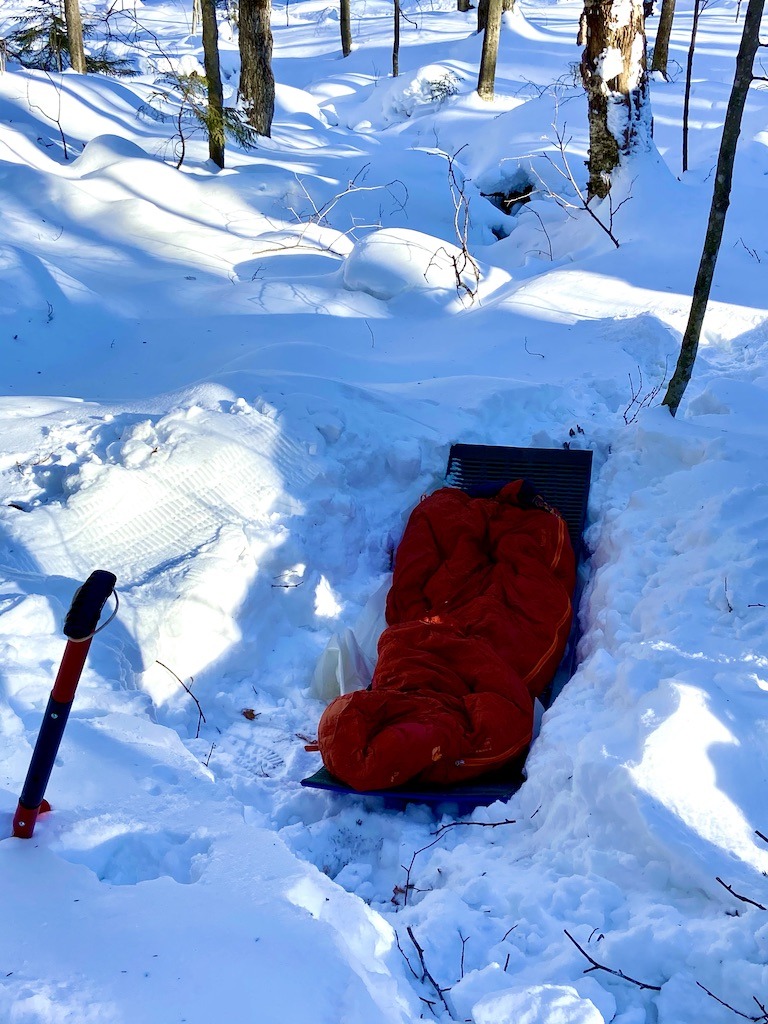
Sleeping Warm while Winter Camping
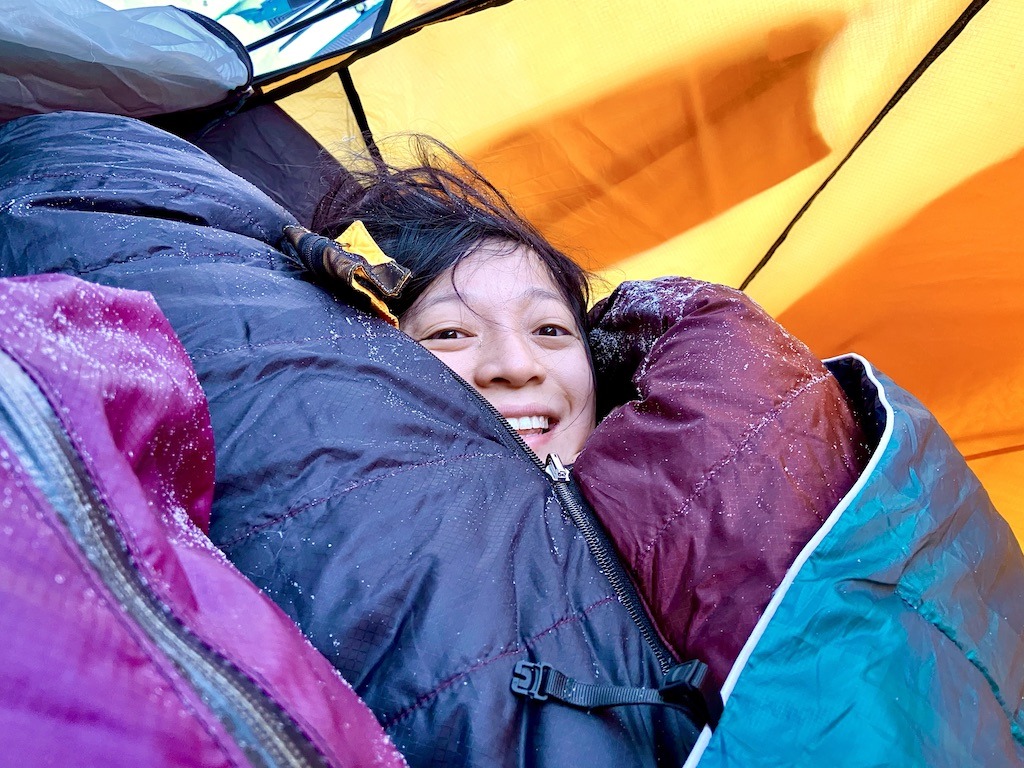
Sleeping warm while winter camping involves a methodical process to get ready. If you are cold when you go to bed, you will probably be cold all night. I like to have a hot drink and go for a walk to warm up before getting in my sleeping bag.
Preparing for sleeping while winter camping
Then the techniques for snuggling into my sleeping bag begin. First, I remove the layers that have been collecting moisture all day (even if you vent well). I have a dry set of polypro and socks for my sleep clothes. Some people are convinced that if they wear all their warm clothes in the sleeping bag they will be warm. But that defeats the purpose of the sleeping bag which is to reflect your body heat back to you. Instead, take off your insulating layers and stuff them in the dead air areas of your sleeping bag so you don’t waste body energy heating up these areas. I like to wrap my feet in my parka and tie my fleece around my waist to keep my midsection warm.
A heat treat is to take a Nalgene of hot water to bed to use to heat up your sleeping bag. Just watch out for leakage! I also like to have a snack such as GORP or an energy bar nearby to stoke my metabolism at about 2 am to get me through the rest of the night. Remember to go to sleep warm. If any part is cold, you can do isometric exercises in your bag to warm up.
Wearing a hat to bed and cinching the drawstring of your sleeping bag tightly will keep your top half warm. Furthermore, the most common reason for getting cold at night is slipping off your sleeping pad and encountering the cold ground. Therefore, make sure you are sleeping on a flat surface. It’s best to align your sleeping pad with tentmates’ pads and all snuggle together.
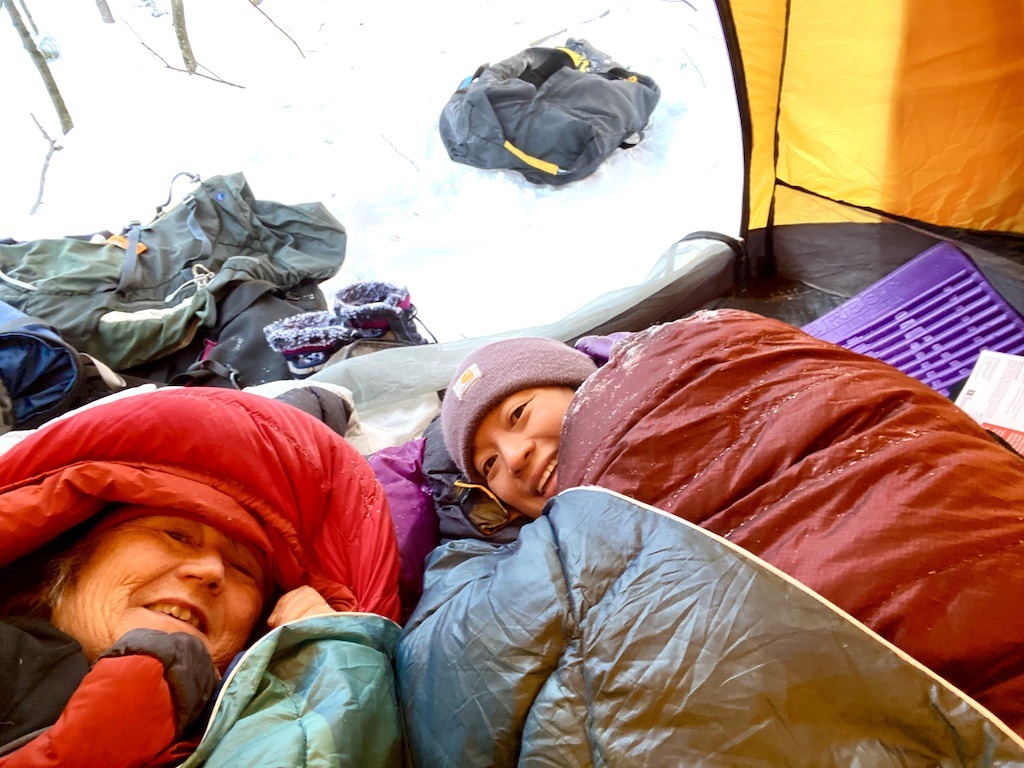
More tips for staying warm at night
Here’s the news you don’t want to hear. If you need to pee in the middle of the night, holding it will just make you colder as your body needs to heat up the extra liquid too. So, jump out and relieve yourself. You will be astounded at how much warmer you’ll be afterward.
Anything you don’t want to freeze should be in your sleeping bag with you. Batteries, phone, water bottle, damp clothes/gloves to dry out all are your sleep mates. I like to use a liner bag or my super warm Rumpl blanket inside my sleeping bag to protect me from these potentially chilly objects wandering around in my bag.
With careful preparation for sleeping, you can snooze warmly in even the coldest nights.
Gear for Winter Camping
The proper clothing and gear for winter camping are essential. Winter equipment can be expensive. However, there are alternatives that you can use and still be a happy winter camper. This is the gear I use and trust after many years of fine-tuning. Contact me with any questions or for alternatives to the gear listed.
Winter Camping Gear List
Personal gear
- Backpack ( 50-70 L size)
- Thermarest or Ensolite RidgeRest sleeping pad
- Winter sleeping bag
- Sleeping bag liner or Rumpl Nano blanket
- Wide mouth water bottle
- Thermos or insulated water bottle
- Cup, bowl, utensils
- Snowshoes, backcountry skis, or microspikes
- Headlamp with extra batteries
- Pocket knife or multi-tool
- Handwarmers
Clothing
- Wicking layer-top and bottom
- Insulating layer-top
- Shell layer
- Fleece pants
- Shell layer -bottom
- Parka
- Winter Boots- Sorel boots or insulated hiking boots
- 2-4 pairs of merino wool and synthetic liner socks
- Gaiters
- Layered glove set: insulated gloves, lightweight inner glove (get these at the dollar store)
- Warm hat
- Sunglasses
- Neck gaiter or buff
Group Gear
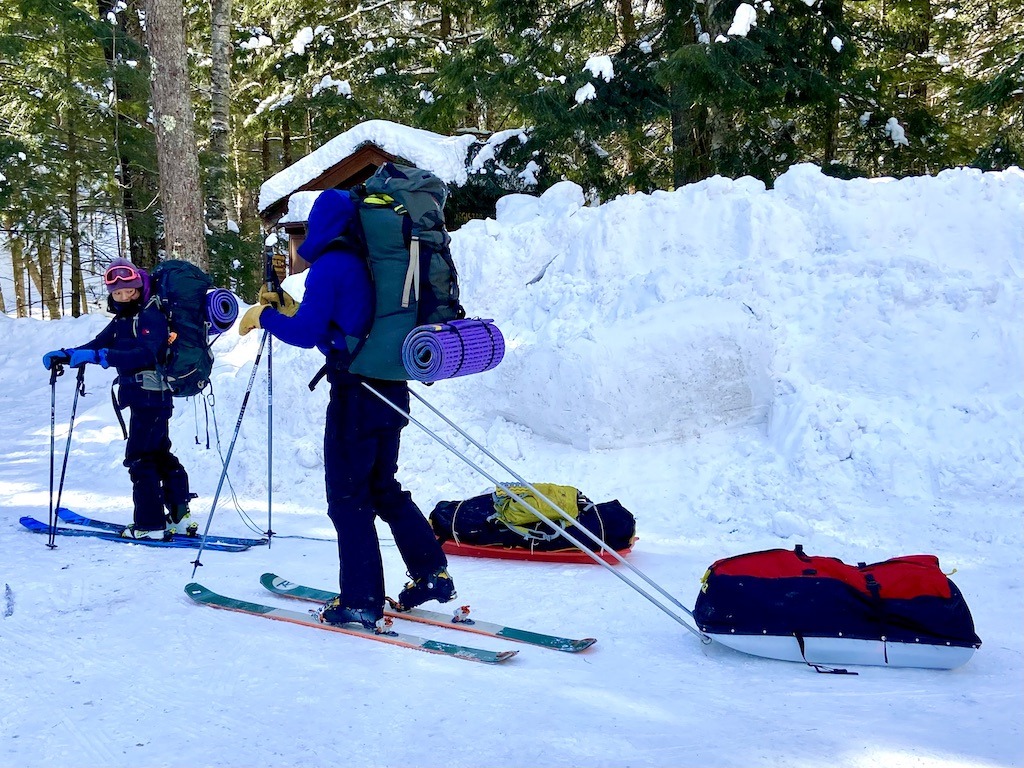
- 3 or 4 season tent with ground cloth
- Liquid gas stove with fuel bottles
- Stove pad
- Pot kit with kitchen gear
- Snow shovel(s)
- Snow saw
- Sled or Pulk
- First Aid Kit
For more detailed explanations of my favorite gear, check out this post. Also, I use much of my paddling camping gear for winter camping. There’s lots of cross-over!
Thoughts for Winter Camping Beginners
Of course, advice such as go with experienced campers or go on a guided trip is always sound. However, that might not be possible and it shouldn’t keep you from trying out winter camping.
I advise beginning winter campers to it try out when the weather is less cold. Avoid the icebox months of January and February. March is a great month for winter camping as the days are longer and the temperatures less severe. Also, make your hike into your winter camp short at first. You will have more time to set up a solid winter camp if you didn’t burn yourself out with the approach. Have a backup plan, too. Recently, as I ventured out in minus 40 F. windchill weather, I made arrangements to stay in a friend’s heated greenhouse if we had to evacuate due to the cold.
Alternative gear
There are gear modifications that prevent you from having to buy lots of expensive winter gear. You can certainly use a 3 season tent or a tarp pitched over a snow tunnel or snow walls. A 3 season sleeping bag can be made suitable for winter by adding a lightweight sleeping bag inside it. The most important heat loss when sleeping in the winter is through the ground so bring a couple of sleeping pads. In this case, less expensive sleeping pads such as a Ridge Rest are actually the best.
Most of the insulating layers needed for winter camping can be picked up at a thrift store. I use dollar store plastic picnic table covers for ground cloths.
Kids’ sleds are excellent for hauling gear. You can customize by drilling holes for parachute cord to tie gear on the sled. A cheap lightweight plastic shovel can substitute for the avalanche digging shovel.
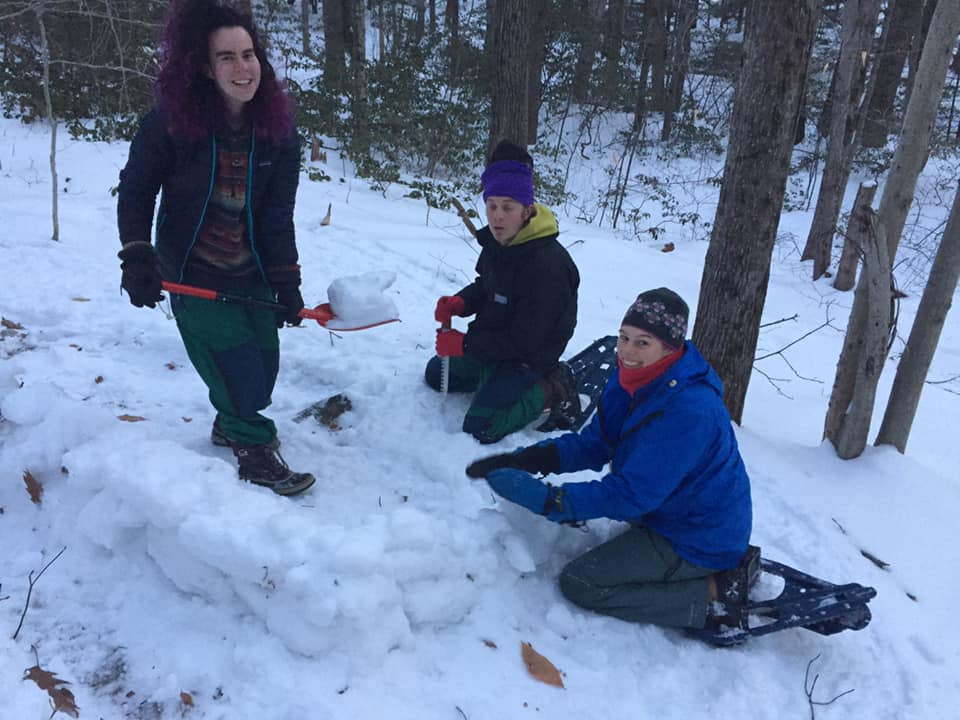
Staying warm in the winter depends on techniques and adequate gear. Therefore, if you are meticulous about staying dry and using some of the tips listed in the article you’ll be able to have a wonderful winter camping experience. Then you will experience firsthand the 12 reasons to love winter camping.
Pin it for later!
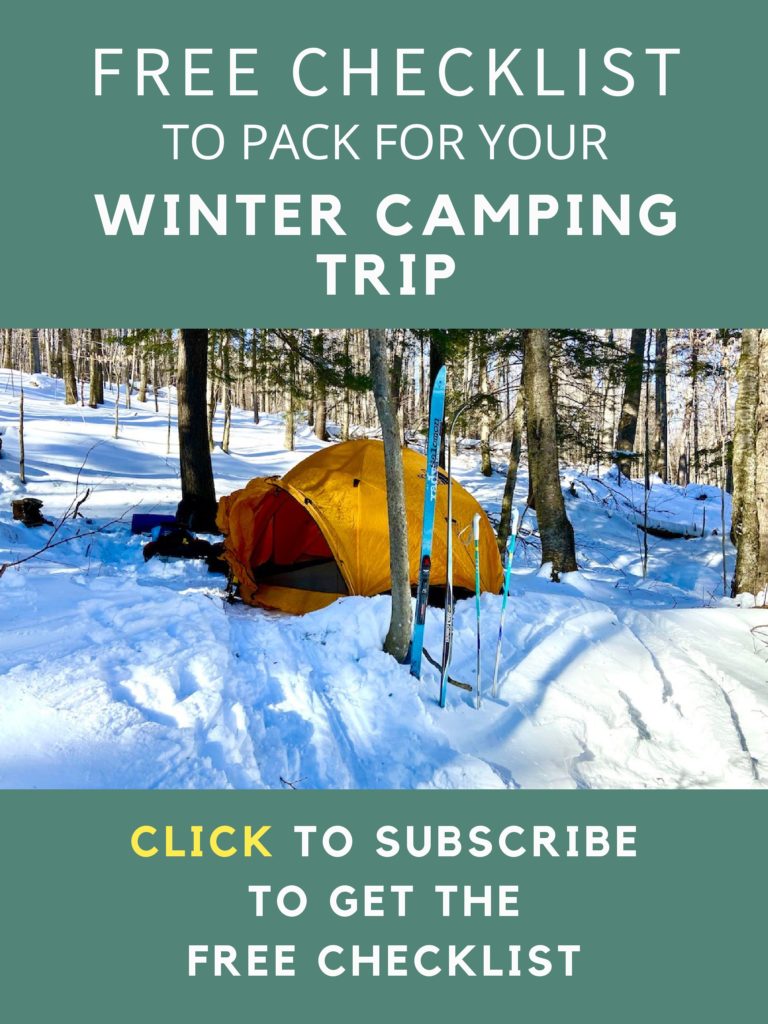
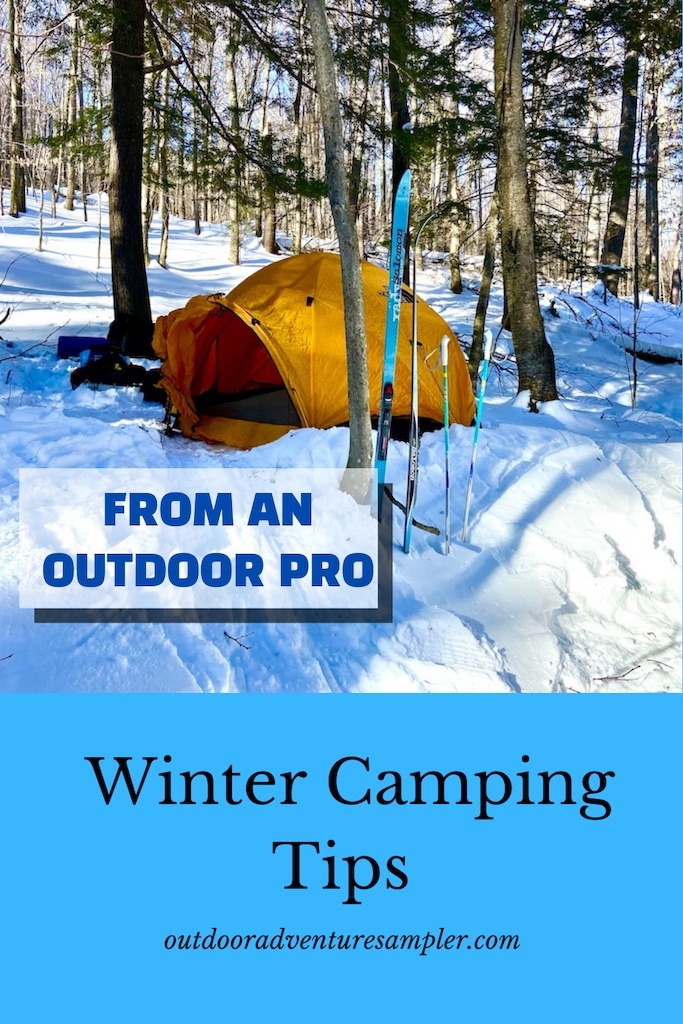
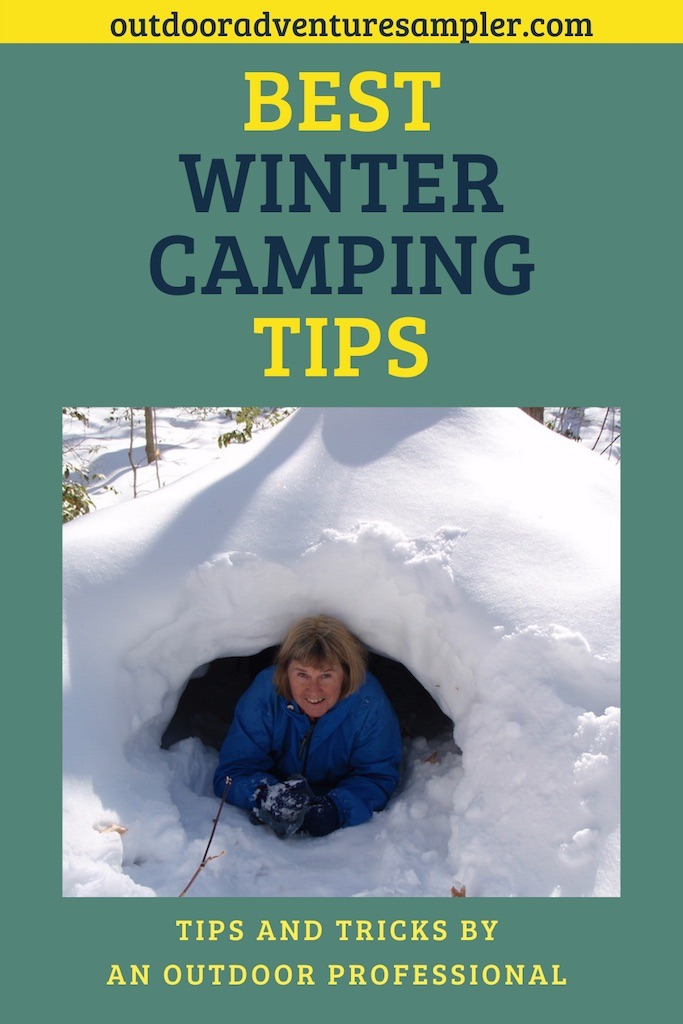
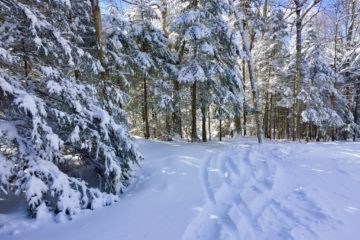
22 Comments
Jamie Sharpe · March 13, 2021 at 9:28 pm
I love the comment about no bugs! It’s been forever since I’ve done this, building igloos is super fun!
kmf · March 13, 2021 at 10:05 pm
I love this post! I just discovered the love of winter hiking for much of the same reasons as you’ve highlighted for winter camping. I’m not a camper, but have been looking into lodging alternatives as I hike at all our state parks in Minnesota. So may give winter camping a try. I’ve always wanted to build an ice/snow bar so thinking your tips will help!
Travelling Tam · March 14, 2021 at 1:30 am
A great post! We’re now in Autumn now but as soon as winter hits my partner and I were discussing going snow camping ASAP! We love our camping and go away most weekends and have some great gear, but I’ve never camped in the snow so it will be my first time! I am excited and I’ll be referring back to this before I go!
Jenni / Out in the Nature · March 14, 2021 at 3:55 am
Winter camping is not for all, but there are many pros in it. Trying it safely with an experienced outdoor pro or at least with the pro tips is a good idea. I don’t know if there is something wrong with my body but it doesn’t allow me to fall asleep if it’s cold on my face. My brain goes like: “Don’t fall asleep or you’ll die!” That’s annoying.
Krista · March 14, 2021 at 5:19 am
I hadn’t actually considered winter camping before, but I also didn’t make the connection that there would be no annoying bugs either! You may have changed my mind about it!
SUSAN W LINTON · March 14, 2021 at 8:28 am
I love this post. It reminds me of the stories about winter camping with the Boy Scouts. They would have loved to have all this knowledge before they went out and froze. As always, your photos are the perfect illustration to the blog. Nice job.
Shelley · March 14, 2021 at 11:27 am
I’m from/live in the tropics, so I honestly didn’t even know winter camping was something people did… but I must admit the #1 NO BUGS seems like good motivation! Also, love the part about testing your grit… It’s always great to test our limits, and winter camping does seem like the place to do that.
Helena · March 14, 2021 at 5:32 pm
I didn’t know that about needing to pee makes you colder! I’m permanently cold and also always need the toilet haha! Great tips!
Lekha Chellani · March 14, 2021 at 9:01 pm
Wow, winter camping looks so much fin. I wish I gather enough courage to brave the winters for a camping trip one day. Despite living in Northeast US for the past 6 years, I haven’t been used to the harsh winters haha. Lovely and informative post.
Margarita · March 15, 2021 at 2:13 am
It’s hard to imagine camping in the snow from Australian summer, but it sounds incredible. The tents with stoves look super cozy. Not an adventure for the fair of heat though 🙂
Josy A · March 15, 2021 at 3:04 pm
This is super helpful Karen! I have been keen to attempt winter camping, but I am nervous to give it a go as I get so cold even camping in the summer. I guess I need to take the plunge and maybe try car camping in winter first…so at least I’d be able to carry in extra piles of blankets!
Great tips for things like carrying your water bottle upside down and for keeping water/batteries in your sleeping bag overnight!
Tara · March 15, 2021 at 8:51 pm
Saving this one! I need to drill down my gear and organization skills for winter camping so I can just do it!
Tranquil Trekker · March 15, 2021 at 10:00 pm
This is one I’ve never had the guts to try. Thanks for the tip on putting the water bottle upside down to keep the cap from freezing, I’ll have to remember that for some of our winter hikes.
Kristen · March 16, 2021 at 11:28 am
In Minnesota, the best thing about winter is that there are no mosquitos! They go crazy in the summer.
Krista · March 17, 2021 at 12:24 pm
There are definitely a lot of perks of camping in the winter, but I am such a baby in the cold I don’t know how long I would last! haha It would be a great challenge though. Great article!
Nora · March 17, 2021 at 1:28 pm
Another great snowy post, Karen 🙂 I love winter hiking and camping just because the landscapes are so different, but you’ve made very good points to even convert the summer hikers 🙂
Xin · March 17, 2021 at 1:49 pm
What useful tips for winter camping! My partner is trying to get me to camp more, but I am a bug MAGNET. I love winter trips though (we ski a lot!) so possibly combining winter and camping is the way to go!
Bozena · March 18, 2021 at 3:36 am
What a gorgeous article! We are planning to travel to do winter camping outside next winter and I saved this article since it has so much useful information. Thanks for sharing! Love it!!!
Kitti · March 18, 2021 at 3:51 am
I’ve never camped in winter but would love to try it out one day. I love the fact that there are no bugs plus you can eat as much as you like.
Ummi | Ummi Goes Where? · March 19, 2021 at 4:50 am
Thank you so much for this super detailed guide. I really needed it. Coming from Southeast Asia, I have never experienced winter camping, but I would love to in the near future.
Susanna · March 28, 2021 at 6:41 am
This is the best guide on winter camping I’ve read! I’m a huge backcountry camper and I grew up in Alaska, but despite that, I’m still a bit cautious of winter camping and tend to avoid it. Thanks for giving me some confidence to do it on my own! Saving this for later.
Jenfer Lowrance · December 17, 2022 at 4:37 am
Did you suffer from any disease during camping?